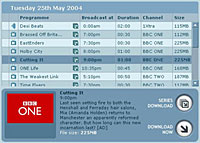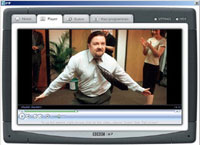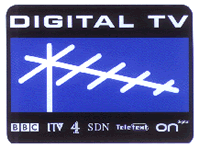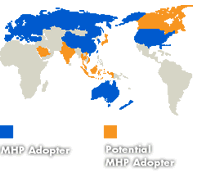 Xbox 360, Microsoft’s successor to their popular Xbox gaming console, will be “unleashed” tonight at a celebrity-packed launch broadcast on MTV, which shows at 8pm in the UK. It was launched on US MTV last night.
Xbox 360, Microsoft’s successor to their popular Xbox gaming console, will be “unleashed” tonight at a celebrity-packed launch broadcast on MTV, which shows at 8pm in the UK. It was launched on US MTV last night.
With a press release positively hyperventilating with hyperbole, Microsoft breathlessly extols the virtues of their new games machine, dramatically waffling on about “a dawn of a new era in entertainment.”
Unlike the manly, chunky lines of the first-generation Xbox, the 360 has been given the ladyboy treatment, with smooth, concave lines covering the rippling muscle lurking below.
And there certainly is a beast in the box, with the unit powered by a custom-made IBM PowerPC-based three-core chip running at 3.2GHz, supported by 512MB of GDDR3 RAM – enough beefy brawn to keep up with even the nippiest modern PCs.
Graphics performance should be speedier than a rocket-assisted rabbit too, with an ATI GPU running at 500MHz, backed up by 10MB of embedded DRAM.
 The Xbox will ship with a 12X dual-layer DVD-ROM drive – supporting progressive-scan DVD movies and a host of DVD and CD formats – three USB 2.0 ports, two memory unit slots and support for four wireless game controllers.
The Xbox will ship with a 12X dual-layer DVD-ROM drive – supporting progressive-scan DVD movies and a host of DVD and CD formats – three USB 2.0 ports, two memory unit slots and support for four wireless game controllers.
Users will also be able to stream media from portable devices or Windows XP PCs, as well as rip music to the Xbox’s detachable (and upgradeable) 20GB hard drive.
Networking needs are catered for with a built-in Ethernet port and support for 802.11a, b, and g Wi-Fi protocols.
“With the first generation of Xbox, our ambition was to change the way people think about video games,” said Robbie Bach, chief Xbox officer at Microsoft. “Starting today with Xbox 360, our ambition is to transform the way people play games and have fun.”
Microsoft – never one to understate their case – are claiming that they will “unleash the greatest game lineup in the history of video games” when the Xbox launches in North America, Europe and Japan over Christmas.
They’ve certainly persuaded a gaggle of major league gaming companies to come onboard, with initial releases including NBA 2K6, Call of Duty 2, QUAKE 4, Madden NFL 06, Need for Speed Most Wanted and Tiger Woods PGA TOUR 06.
 “Xbox 360 marks the beginning of a renaissance in video games,” whooped Don Mattrick, president of Worldwide Studios for Electronic Arts. “The unbelievable Xbox 360 games in development at Electronic Arts will accelerate the industry’s mission to make video games the pre-eminent form of all entertainment.”
“Xbox 360 marks the beginning of a renaissance in video games,” whooped Don Mattrick, president of Worldwide Studios for Electronic Arts. “The unbelievable Xbox 360 games in development at Electronic Arts will accelerate the industry’s mission to make video games the pre-eminent form of all entertainment.”
All the games are designed for high-definition, wide-screen televisions, although they’ll work on regular TVs.
Players will be able to access Microsoft’s free Xbox Live online service, which allows them to connect with friends through Xbox Live voice chat, send and receive text and voice messages and stuff their detachable Xbox 360 hard drive full of downloadable demos, trailers, new game levels, maps, weapons, vehicles, skins and community-created content
Gamers who shell out for the premium service, Xbox Live Gold, can join multiplayer online games and enjoy enhanced options for online game matchmaking and a greater ability to provide feedback on opponents.
 Naturally, gamers love to customise their experience, so there’s a camera option to let vain players add their mugshots into games or even see their friends onscreen as they frag them to an inch of their worthless lives.
Naturally, gamers love to customise their experience, so there’s a camera option to let vain players add their mugshots into games or even see their friends onscreen as they frag them to an inch of their worthless lives.
As is the current vogue, the appearance of the actual Xbox can be customised too, with a range of interchangeable Xbox Faces on offer.
Although the system is aimed at mad-for-it gamers, the Xbox is also a full entertainment system offering DVD movie, CD music and photo playback support.
So long as they’re equipped with a USB 2.0 port, MP3 players, digital cameras and Windows XP-based PC port can all plug into an Xbox 360 system to stream music and photos.
 Xbox 360 players can also access recorded TV and digital movies, music, video and photos stored on Windows XP Media Center Edition 2005-based PCs through any Xbox 360 system in the house.
Xbox 360 players can also access recorded TV and digital movies, music, video and photos stored on Windows XP Media Center Edition 2005-based PCs through any Xbox 360 system in the house.
We’ve yet to get our greasy paws on a machine, but Microsoft have certainly raised the stakes with their new Xbox, although arch rivals Sony have yet to, err, unleash their PlayStation 3, a potentially more powerful box offering support for new high-capacity Blu-ray discs.
With both units enjoying enthusiastic support from game makers and gamers, some of the real bloody battles could soon be taking place off-screen.
Promo video for Xbox 360 (Windows Media)
If you thought Xbox 360 was just about gaming, skip to 3 minutes into the video to see how they’re transforming it into a media centre.
XBox
 More and more people are using computers or portable players for music, even though traditional radio still leads the competition, according to a recent market study.
More and more people are using computers or portable players for music, even though traditional radio still leads the competition, according to a recent market study. Last week, Yahoo revealed their determination to become big noise in the music industry, unveiling a music subscription service that significantly undercuts their rivals.
Last week, Yahoo revealed their determination to become big noise in the music industry, unveiling a music subscription service that significantly undercuts their rivals. Shure have just released their E4c earphones. These are the in-ear type with various mouldings (sleeves) that fit on to the actual phones so you can get a comfortable fit.
Shure have just released their E4c earphones. These are the in-ear type with various mouldings (sleeves) that fit on to the actual phones so you can get a comfortable fit. While sitting on the underground you could just hear the station announcements on the public address system, but not much else. The music playing was ambient dance music and you could really make out the nuances etc. Unfortunately the only downside of blotting out everything made you realise even more how miserable everyone looked.
While sitting on the underground you could just hear the station announcements on the public address system, but not much else. The music playing was ambient dance music and you could really make out the nuances etc. Unfortunately the only downside of blotting out everything made you realise even more how miserable everyone looked. BBC New Media is to extend trials of its interactive Media Player (iMP), allowing viewers to download material from 500 hours of its television and radio programming.
BBC New Media is to extend trials of its interactive Media Player (iMP), allowing viewers to download material from 500 hours of its television and radio programming. The 5,000 trialists will be able to search for programmes they want to watch, filter programmes by channel, select subtitles and, in the case of some series, to collect and watch episodes that they may otherwise have missed.
The 5,000 trialists will be able to search for programmes they want to watch, filter programmes by channel, select subtitles and, in the case of some series, to collect and watch episodes that they may otherwise have missed. The pilot will use DRM software to delete programmes seven days after the programme has aired on TV, ensuring that users can no longer watch the content after that time. The digital rights system will also prevent users emailing the files to their chums or sharing it via disc.
The pilot will use DRM software to delete programmes seven days after the programme has aired on TV, ensuring that users can no longer watch the content after that time. The digital rights system will also prevent users emailing the files to their chums or sharing it via disc. AOL today trumpeted its intention to muscle into the UK phone business with the launch of a home service offering unlimited calls for an introductory flat rate of £7.99 (~US$14, ~€11) per month.
AOL today trumpeted its intention to muscle into the UK phone business with the launch of a home service offering unlimited calls for an introductory flat rate of £7.99 (~US$14, ~€11) per month. Johnny-come-lately subscribers signing up after 30 June 2005 will pay this standard monthly subscription fee.
Johnny-come-lately subscribers signing up after 30 June 2005 will pay this standard monthly subscription fee. Microsoft has announced that it would begin testing OneCare Live – a PC-health care fix-it all application – with a general release sometime next year.
Microsoft has announced that it would begin testing OneCare Live – a PC-health care fix-it all application – with a general release sometime next year. OneCare is a separately sold subscription-based service designed to work as a mainly “hands-off” application, quietly doing its good deeds in the background while sending security updates to users’ computer systems without them having to download or install the fixes.
OneCare is a separately sold subscription-based service designed to work as a mainly “hands-off” application, quietly doing its good deeds in the background while sending security updates to users’ computer systems without them having to download or install the fixes. Natalie Mouyal of
Natalie Mouyal of  Generally, countries have tended mix the two strategies. Viewers have benefited from both an increase in the number of television service programmes available, as well as interactive television services. Yet, this combination has not always allowed for an impressive take-off of MHP based interactive services. In the case of Finland, consumers could choose between a zapper set-top box that allows them to access more television service programmes or an MHP-enabled set-top box that allows them to access both the increased number of television services programmes as well as the interactive services. However, MHP-enabled set-top boxes make up only 5% of all set-top boxes currently purchased.
Generally, countries have tended mix the two strategies. Viewers have benefited from both an increase in the number of television service programmes available, as well as interactive television services. Yet, this combination has not always allowed for an impressive take-off of MHP based interactive services. In the case of Finland, consumers could choose between a zapper set-top box that allows them to access more television service programmes or an MHP-enabled set-top box that allows them to access both the increased number of television services programmes as well as the interactive services. However, MHP-enabled set-top boxes make up only 5% of all set-top boxes currently purchased. It has been assumed that many consumers will invariably prefer the cheaper zapper set-top box to a more expensive MHP-enabled set-top box. However, this reasoning disregards the type of interactive services offered. For example, should viewers find interactive services compelling and easy to use, they may be willing to spend the extra money necessary for an interactive set-top box. Thus, it would seem that consumer education is key to the successful roll-out of interactive services.
It has been assumed that many consumers will invariably prefer the cheaper zapper set-top box to a more expensive MHP-enabled set-top box. However, this reasoning disregards the type of interactive services offered. For example, should viewers find interactive services compelling and easy to use, they may be willing to spend the extra money necessary for an interactive set-top box. Thus, it would seem that consumer education is key to the successful roll-out of interactive services. The BBC has let rip with a new beta service that invites Web developers and designers outside of the organisation to start fiddling about with their content and “create cool new things”.
The BBC has let rip with a new beta service that invites Web developers and designers outside of the organisation to start fiddling about with their content and “create cool new things”. The UK broadcasting goliath made a commitment to support social innovation in response to last year’s Graf Report, and this is echoed in their plans to develop an open community where people can share expertise, ideas, and collaborative efforts.
The UK broadcasting goliath made a commitment to support social innovation in response to last year’s Graf Report, and this is echoed in their plans to develop an open community where people can share expertise, ideas, and collaborative efforts. It’s not all about profit though, with the BBC hoping that contributors will create prototypes on their Web sites to be freely shared with others for non-commercial use.
It’s not all about profit though, with the BBC hoping that contributors will create prototypes on their Web sites to be freely shared with others for non-commercial use. Microsoft ubermensch Bill Gates foresees mobile phones overtaking MP3s as the top choice among portable music players, while dismissing the popularity of Apple’s iPod player as unsustainable.
Microsoft ubermensch Bill Gates foresees mobile phones overtaking MP3s as the top choice among portable music players, while dismissing the popularity of Apple’s iPod player as unsustainable. “If you were to ask me which mobile device will take top place for listening to music, I’d bet on the mobile phone for sure,” Gates told the newspaper.
“If you were to ask me which mobile device will take top place for listening to music, I’d bet on the mobile phone for sure,” Gates told the newspaper. Xbox 360, Microsoft’s successor to their popular Xbox gaming console, will be “unleashed” tonight at a celebrity-packed launch broadcast on MTV, which shows at 8pm in the UK. It was launched on US MTV last night.
Xbox 360, Microsoft’s successor to their popular Xbox gaming console, will be “unleashed” tonight at a celebrity-packed launch broadcast on MTV, which shows at 8pm in the UK. It was launched on US MTV last night. The Xbox will ship with a 12X dual-layer DVD-ROM drive – supporting progressive-scan DVD movies and a host of DVD and CD formats – three USB 2.0 ports, two memory unit slots and support for four wireless game controllers.
The Xbox will ship with a 12X dual-layer DVD-ROM drive – supporting progressive-scan DVD movies and a host of DVD and CD formats – three USB 2.0 ports, two memory unit slots and support for four wireless game controllers. “Xbox 360 marks the beginning of a renaissance in video games,” whooped Don Mattrick, president of Worldwide Studios for Electronic Arts. “The unbelievable Xbox 360 games in development at Electronic Arts will accelerate the industry’s mission to make video games the pre-eminent form of all entertainment.”
“Xbox 360 marks the beginning of a renaissance in video games,” whooped Don Mattrick, president of Worldwide Studios for Electronic Arts. “The unbelievable Xbox 360 games in development at Electronic Arts will accelerate the industry’s mission to make video games the pre-eminent form of all entertainment.” Naturally, gamers love to customise their experience, so there’s a camera option to let vain players add their mugshots into games or even see their friends onscreen as they frag them to an inch of their worthless lives.
Naturally, gamers love to customise their experience, so there’s a camera option to let vain players add their mugshots into games or even see their friends onscreen as they frag them to an inch of their worthless lives. Xbox 360 players can also access recorded TV and digital movies, music, video and photos stored on Windows XP Media Center Edition 2005-based PCs through any Xbox 360 system in the house.
Xbox 360 players can also access recorded TV and digital movies, music, video and photos stored on Windows XP Media Center Edition 2005-based PCs through any Xbox 360 system in the house. Telewest Broadband today announced plans to transform its TV service, giving consumers greater access and control over additional digital programmes.
Telewest Broadband today announced plans to transform its TV service, giving consumers greater access and control over additional digital programmes. There will also be a mix of free and subscription services including popular TV series, music videos and niche content.
There will also be a mix of free and subscription services including popular TV series, music videos and niche content. Eric Tveter, president and chief operating officer at Telewest sunk deeper into his deluxe executive chair and glossed: “We are transforming TV as we know it by giving consumers both a superb choice of programmes and the flexibility to watch them whenever they want. We don’t ever want to hear our customers say there’s nothing on the box or that they have missed their favourite programme.”
Eric Tveter, president and chief operating officer at Telewest sunk deeper into his deluxe executive chair and glossed: “We are transforming TV as we know it by giving consumers both a superb choice of programmes and the flexibility to watch them whenever they want. We don’t ever want to hear our customers say there’s nothing on the box or that they have missed their favourite programme.”